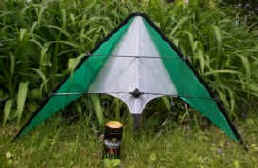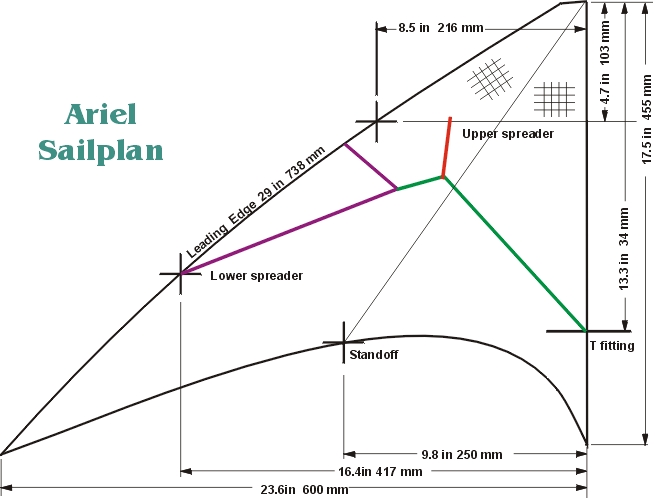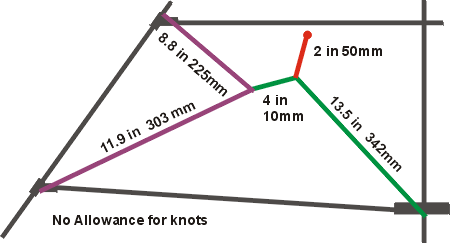|
Ariel Plan
This little hummingbird is made of 1570 (4mm) spars and fittings with about a half-yard of nice quiet nylon. Yes, the upper spreader is too low, but it works. I'll raise it on the inevitable UL version, with a .080 frame and lighter sail. The goal was a very fast and durable medium-to-high wind kite and the result makes up for some of my dead-end projects. Ariel is a composite of other kites, with traits selected for stability, resulting in a low-aspect sail with long whiskers, making a deep kite. At launching, it hesitates slightly due to the heavy frame but once airborne it's stiff and smooth, with the tensioned trailing edge leaving a soft white-noise sound. A not-unpleasant bit of over-steer allows fast pirouettes but tracking is excellent. Steering input is very sensitive but there is enough feedback to give you a feel for the kite. Axles are fast and leading edge launches are a breeze. Wind range seems to be in the 6-25 mph range, and at even higher winds it still works well, but it's hard to see! The beer can is for scale reference only. After flying the Ariel a while I got to sample a Micron for the first time and found it somewhat similar, though the Ariel handles much higher winds. Although mine has heavy spars for gale winds, I would recommend using .098 rod instead.
 Yes, the upper spreader is too
low but it works. I'll raise it on the inevitable UL version, with a .080
frame and lighter sail. The goal was a very fast and durable
medium-to-high wind kite, and the result makes up for some of my dead-end
projects. Ariel is a composite of other kites, with traits selected for
stability resulting in a low-aspect sail, with long whiskers, making a
deep kite. At launching in light winds, it hesitates slightly due to the heavy
frame but once airborne it's stiff and smooth, with the tensioned
trailing edge leaving a soft white-noise sound. A not-unpleasant bit of oversteer
allows fast pirouettes but tracking is good. Steering input is very sensitive, but there is enough feedback to give you
a feel for the kite. Axles are fast, and leading edge launches are a
breeze. Wind range seems to be in the 5-15mph range. At higher
speeds
it's hard to see! The beer can is for scale reference only. The plan assumes some experience with kite
making and the ability to print the sail plan to size. Nothing in the construction is
special, just basic kite construction. Morten's
version.
Yes, the upper spreader is too
low but it works. I'll raise it on the inevitable UL version, with a .080
frame and lighter sail. The goal was a very fast and durable
medium-to-high wind kite, and the result makes up for some of my dead-end
projects. Ariel is a composite of other kites, with traits selected for
stability resulting in a low-aspect sail, with long whiskers, making a
deep kite. At launching in light winds, it hesitates slightly due to the heavy
frame but once airborne it's stiff and smooth, with the tensioned
trailing edge leaving a soft white-noise sound. A not-unpleasant bit of oversteer
allows fast pirouettes but tracking is good. Steering input is very sensitive, but there is enough feedback to give you
a feel for the kite. Axles are fast, and leading edge launches are a
breeze. Wind range seems to be in the 5-15mph range. At higher
speeds
it's hard to see! The beer can is for scale reference only. The plan assumes some experience with kite
making and the ability to print the sail plan to size. Nothing in the construction is
special, just basic kite construction. Morten's
version.
This
kite isn't named for the Arial
typeface or a Disney cartoon character, but for the British maker of
the Square Four motorcycle. A very fast bike with pathetically weak
brakes.
I intend to make another sing a .098
rod frame, which would be a better kite for average winds.
|
|
Frame Dimensions |
| Leading edge |
1570 Carbon |
30 inches |
760 mm |
| Spine |
1570 Carbon |
18 inches |
460 mm |
| Upper Spreader |
1570 Carbon |
14.4 inches |
368
mm |
| Lower spreader |
1570 Carbon |
13 inches |
330 mm |
| Stand-offs |
.080 Carbon |
4 inches |
100 mm |
|
Parts and Materials |
| Leading edge strip and nose |
3.9 ounce Polyester 1 5/8 inches wide |
| Sail |
1/2 ounce Nylon |
| Leech line |
50 pound Polyester |
| Bridle line |
75 pound Polyester |
| Nocks |
Mini 1570 |
| Leading edge connectors |
APA Mini, with "doohickey" clips |
| Standoff to Spreader |
APA teardrop |
| Standoff to sail |
HQ- type clip-on |
| T-connector |
Exel plastic |


|
Bridle Dimensions |
 |
|
A prusik knot attaches the tow loop
(red) to the inhaul line (green), and another one ties the inhaul (green) to the purple outhaul (purple). |
|